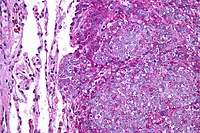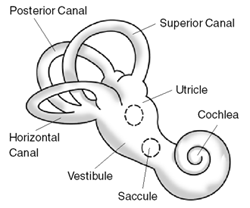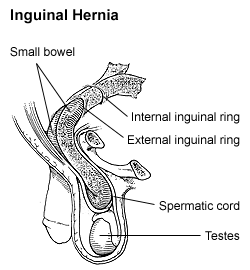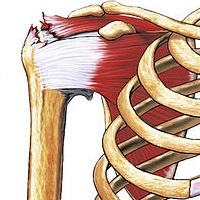-
Dissociative Identity Disorder
Wikipedia
Comorbid disorders can include substance abuse , eating disorders , anxiety disorders , post-traumatic stress disorder (PTSD), and personality disorders . [8] A significant percentage of those diagnosed with DID have histories of borderline personality disorder and bipolar disorder . [27] [ disputed (for: bipolar is uncommon as a comorbidity, PTSD is more common) – discuss ] Further, data supports a high level of psychotic symptoms in individuals with DID, and that both individuals diagnosed with schizophrenia and those diagnosed with DID have histories of trauma. [28] [ disputed (for: misinterpretation of source – Schneider FRS more common but they are no psychotic within DID and no longer used as psychotic diagnostic criteria) – discuss ] Other disorders that have been found to be comorbid with DID are somatization disorders, major depressive disorder , as well as history of a past suicide attempt, in comparison to those without a DID diagnosis. [29] Individuals diagnosed with DID demonstrate the highest hypnotizability of any clinical population. [23] The large number of symptoms presented by individuals diagnosed with DID has led some clinicians to suggest that, rather than being a separate disorder, diagnosis of DID is actually an indication of the severity of the other disorders diagnosed in the patient. [15] [ undue weight?
-
Transient Global Amnesia
Wikipedia
Other putative associations [ edit ] There have been assertions of a possible link between TGA and the use of statins (a class of drug used in treating cholesterol). [27] [28] En bloc memory loss which is total, permanent, and irrecoverable can occur as an alcoholic "black out," usually lasting longer than an hour and up to 2–5 days.
-
Health Impact Of Asbestos
Wikipedia
There is experimental evidence that very slim fibers (<60 nm, <0.06 μm in breadth) tangle destructively with chromosomes (being of comparable size). [28] [29] This is likely to cause the sort of mitosis disruption expected in cancer. ... PMID 11108782 . ^ Asbestos in Schools . US EPA (28 June 2006). Retrieved 10 January 2012. ^ Asbestos – Health Effects ATSDR – Agency for Toxic Substances and Disease Registry (1 April 2008). Retrieved 4 June 2013. ^ Basic Information | Asbestos | US EPA (28 June 2006). Retrieved 10 January 2012. ^ ATSDR – Asbestos – Detecting asbestos-related health problems . ... "Dirty Little Secret". Science News . 170 (2): 26–28. doi : 10.2307/4017077 . JSTOR 4017077 . ^ " Not in Their Back Yard ", Mother Jones , May/June 2007. ^ Meeker, G.P.; Lowers, H.A.; Swayze, G.A.; Van Gosen, B.S.; Stutley, S.J.; Brownfield, I.K. ... Retrieved on 2015-10-17. ^ Japanese Asbestos Scandal Archived 2012-12-18 at Archive.today . Asia Monitor Resource Center. 28 September 2007 ^ Asbestos use banned on all products from this month .
-
Jaw Abnormality
Wikipedia
Cone Beam Computed Tomography (CBCT) has gained popularity for the use of radiographic examinations of facial bones for purpose of planning complex orthognathic surgery , especially involving significant facial asymmetry. [17] A 3D facial construction model can be utilised in more complex malocclusion to help plan management. [28] Classification [ edit ] Size [ edit ] Micrognathia Mandibular micrognathia is the condition when lower jaw is smaller than normal. [29] Failure of the ramus to develop will give rise to micrognathia. [30] Micrognathia can be classified as either congenital or acquired. ... Journal of Orofacial Pain . 23 (1): 28–37. PMID 19264033 . ^ Rumsey N, Clarke A, White P, Wyn-Williams M, Garlick W (December 2004). ... "Background considerations to facial aesthetics" . Journal of Orthodontics . 28 (2): 159–68. doi : 10.1093/ortho/28.2.159 . ... "Orthognathic surgery for patients with maxillofacial deformities". AORN Journal . 92 (1): 28–49, quiz 50–2. doi : 10.1016/j.aorn.2009.12.030 .
-
Ewing's Sarcoma
Wikipedia
The tumor has a unique property of being highly sensitive to radiation, sometimes acknowledged by the phrase "melting like snow", but the main drawback is that it recurs dramatically after some time. [ citation needed ] Antisense oligodeoxynucleotides have been proposed as possible treatment by down-regulating the expression of the oncogenic fusion protein associated with the development of Ewing sarcoma resulting from the EWS-ETS gene translocation. [27] [28] In addition, the synthetic retinoid derivative fenretinide (4-hydroxy(phenyl)retinamide) has been reported to induce high levels of cell death in Ewing sarcoma cell lines in vitro and to delay growth of xenografts in in vivo mouse models. [29] [30] In most pediatric cancers including sarcoma, proton beam radiation (also known as proton therapy ) delivers an equally effective dose to the tumor with less damage to the surrounding normal tissue compared to photon radiation. [31] Prognosis [ edit ] Staging attempts to distinguish people with localized from those with metastatic disease. [32] Most often, metastases locate to the lungs, bone and/or bone marrow.EWSR1, FLI1, EGR2, ERG, ETV1, ETV4, STAG2, CIZ1, NF1, BRD4, DUX4, FLII, NUTM1, TP53, CXCR4, BAP1, RB1, C1orf127, PARP1, RPL24P2, CCND1, SRP14-AS1, FUS, IGF1R, CDKN2A, CD99, CIC, IGF1, BCOR, VEGFA, PIK3CA, PIK3CD, CDK4, PIK3CB, EZH2, PIK3CG, NR0B1, CCNB3, FEV, ATF1, FOXO1, SMUG1, TNFSF10, NFATC2, HLA-A, MYC, TAF15, HIF1A, COL11A2, CAV1, KDM1A, BMI1, CNMD, AKT1, WT1, CCK, PAX3, TNF, KDM3A, STEAP1, MBD2, MDM2, BCL2, COMMD3-BMI1, EWSAT1, ERBB2, ELAVL2, EPHA2, PTEN, ABCB1, ROCK1, DNER, IFNB1, XAGE1A, TNC, FGF2, SH2D1B, HOXD@, XAGE1B, CASP8, LIF, ALK, TGFBR2, STAT3, CTLA4, VIM, SOX2, DDIT3, PAX7, MMP1, MAPK1, MEN1, NKX2-2, NGF, BCL11B, HLA-DOA, MMP9, MET, HGF, RASSF2, NAMPT, TARDBP, NOTCH1, KMT2A, HES1, GLI1, EMG1, DTL, IL2, PDCD1, PDGFRB, PAPPA, IGFBP3, NES, TWIST1, NTRK1, PLK1, RASSF1, CCN3, HTC2, LDHA, NPY, IGF2BP3, PHGDH, MAML3, PTPRC, FAS, ETV5, BCR, FOXM1, TERT, RHD, SMARCB1, S100A1, BRCA1, CSF3, ETS1, EGFR, S100B, CHEK1, ERBB4, ZYX, ENG, TGFB1, E2F3, AURKB, MIR34A, MALAT1, EZR, PTPN13, CBL, CD38, ROCK2, CCND2, FOLH1, CD34, TNFRSF10A, SCG2, HMGA2, REEP5, STRAP, ARID1A, MLXIP, ZBTB16, ZAP70, CHP1, EBNA1BP2, MMRN1, YWHAE, XBP1, WNT5A, MIR708, H3P28, PPRC1, SMARCA5, BCAR1, JTB, YAP1, NR1I3, TMX2-CTNND1, TRIM13, TRIB1, ADAMTS4, RABEPK, SPRY1, RAMP1, ARHGEF2, USP6, STAG1, LANCL1, OLFM1, PIK3R3, HSPB3, SNURF, NR1I2, PROM1, HDAC3, BANF1, TNFRSF10B, TP53I3, ABCC3, BECN1, TP63, USP19, EED, CDK12, TBC1D9, GSTK1, ARMH1, DLX6-AS1, CAVIN1, PGP, MIR20B, MIR193B, FNDC5, CTAG1A, POU5F1P3, LRWD1, POU5F1P4, KDM1B, MARCHF8, RHOV, ASXL1, PRIMA1, CACUL1, CXADRP1, SLCO6A1, IL31RA, BORCS5, FOXP4, PRRT2, SOX2-OT, SH2D4B, ATG4B, ERVFRD-1, MIR34B, MIR31, MIR30D, MIR30A, MIR301A, MIR29B2, MIR29B1, MIR22, MIR21, MIR199B, MIR199A2, MIR335, MIR199A1, MIR186, MIR185, MIR181C, MIR15A, MIR145, MIR139, MIR130B, MIR10B, MIR107, MIRLET7G, CEP41, FOXQ1, SLFN11, FATE1, NME1-NME2, TET2, KRT20, MIR17HG, GDE1, PHF11, PSAT1, CD274, MYLIP, SETD2, IGHV1-12, AGO2, DKK2, PHF19, MIR584, PLA2G15, SUZ12, MIR638, HEY1, SF3B1, KTWS, SATB2, FBXW11, HEATR3, ZNF331, PBK, MRPL41, DCLK3, RITA1, LINGO1, ACCS, AKT1S1, ZNF93, CD276, DHDDS, LIN28A, NKAP, SOX17, LMO3, XYLT2, ZBTB4, KIDINS220, ABHD6, CD248, CCNL1, ACKR3, CHPT1, PRMT8, ACSS2, ACTB, PTK2, TRIP6, FOXC1, GCY, GATA3, GAS6, GAB1, MTOR, FOSB, FOS, FN1, FLT4, FLT3, FHIT, GHRH, FGFR1, FGF4, FCGRT, FAP, EYA3, ERN1, ERF, EPHB2, EPHA3, EMD, GDNF, GJA1, TNNT1, HOXD11, IGF2, IFNG, IFNA13, IFNA1, HSP90AA1, HSPB2, HSPB1, HSPA4, HPRT1, HOXD13, HLA-G, GLG1, HLA-C, HLA-B, NRG1, HDGF, H2AX, GZMB, MSH6, GSTM4, NR3C1, GRB10, EGR1, EGF, EDNRB, AXL, RUNX3, RUNX2, CASR, CASP9, CASP3, CALCB, CALCA, BTK, BID, BDNF, ATR, EDNRA, SERPINC1, ARR3, ARHGAP1, ABCC6, KLK3, APOC3, XIAP, ALDH1A1, ALCAM, ADRB3, CD6, MS4A1, CD86, CD79A, E2F4, DSPP, DPP4, DDX3X, DCC, CYP2C8, CXADR, CTNND1, CTNNB1, CTAG1B, CSF1R, CSE1L, MAPK14, CRP, CEBPB, CDKN2B, CDK6, CDK2, CDH11, CDH2, CDC42, IGL, IHH, IL6, PTPN11, CCL21, S100A12, BRD2, RNF2, RET, REST, RAG2, RAC1, NECTIN2, PTPRD, PTGS2, POU5F1, PTCH1, PSPH, PSMD7, RELN, MAP2K7, MAPK8, PRKCB, PRKCA, PRKAR1A, PRF1, CXCL12, SET, SFRP5, SLC1A5, TMPRSS2, TSPAN7, TLE1, TIE1, THY1, TRBV20OR9-2, TCF4, TBX5, TARBP2, SYP, SYK, SSX1, SST, SRC, SPN, SPG7, SP1, SNRPN, SMN2, SMN1, SLC2A1, PPP1R1A, PMS2, IL9, KIT, MCF2, MCAM, LRP1, LPP, LOX, LGALS3BP, STMN1, RPSA, KRT17, KRAS, KCNA5, PMAIP1, CD82, JUND, JUNB, JUN, JAK1, INSRR, INSR, INSM1, ILK, IL15, MCL1, MDK, MEIS1, MAP3K3, PCNA, PAK3, PAK1, PAFAH1B1, OSM, ROR1, NTRK3, NPTX2, NPM1, NME2, NME1, NNAT, NF2, NCAM1, MYCN, MUC5AC, MSH2, MMP11, MME, MLH1, MGST1, H3P10
-
Diseases Of Poverty
Wikipedia
Clean water is necessary for cooking, cleaning, and laundry because many people come into contact with disease causing pathogens through their food, or while bathing or washing. [28] An ongoing issue of contaminated water in the United States has been taking place in Flint, Michigan . ... Retrieved 2019-12-05 . ^ van Panhuis, Willem G.; Grefenstette, John; Jung, Su Yon; Chok, Nian Shong; Cross, Anne; Eng, Heather; Lee, Bruce Y.; Zadorozhny, Vladimir; Brown, Shawn; Cummings, Derek; Burke, Donald S. (2013-11-28). "Contagious Diseases in the United States from 1888 to the Present" . ... PMID 31112692 . ^ "HIV/AIDS" . www.who.int . Retrieved 28 December 2020 . ^ "History | World TB Day | TB | CDC" . www.cdc.gov . 2018-12-13 . ... PMID 25530634 . ^ "Can Poverty Lead To Mental Illness?" . NPR.org . Retrieved 28 December 2020 . ^ a b UNICEF (Water).
-
Ménière's Disease
Wikipedia
However, the evidence for this is weak. [16] There is no high quality evidence that changing diet by restricting salt, caffeine or alcohol improves symptoms. [25] Physical therapy [ edit ] While use of physical therapy early after the onset of MD is probably not useful due to the fluctuating disease course, physical therapy to help retraining of the balance system appears to be useful to reduce both subjective and objective deficits in balance over the longer term. [4] [26] Counselling [ edit ] The psychological distress caused by the vertigo and hearing loss may worsen the condition in some people. [27] Counseling may be useful to manage the distress, [4] as may education and relaxation techniques . [28] Surgery [ edit ] If symptoms do not improve with typical treatment, surgery may be considered. [4] Surgery to decompress the endolymphatic sac is one option.PRKCB, DTNA, FAM136A, COCH, AQP2, AVP, KCNE1, AQP4, TNF, HLA-DRB1, HLA-C, TRPV4, AQP1, MIF, THRA, TLR3, SLC8A1, SOD2, SLC12A2, RNASE3, CRLF1, SLC4A1, SLC2A1, CCL5, FCGR2C, ADD1, KCNE3, TSHZ1, RAF1, HPGDS, TLR8, TNFRSF12A, PLXNA3, SLC44A2, HRH4, TLR10, SIK1, SEMA3D, VAMAS6, PTPN22, MTRR, NOS3, NOS2, AQP5, AQP6, CASP9, CAV1, CLDN4, CLDN3, ESR1, FCGR2A, FCGR2B, FCGR3A, FCGR3B, GSTM1, HCFC1, HMX2, HSPA1A, HSPA1B, HSPA4, IFNG, IL1A, MTHFR, MTNR1B, MTR, PARP1, NFKB1, NOS1, MICA
- Abortion In Colombia Wikipedia
-
Post-Traumatic Amnesia
Wikipedia
It may be more reliable for determining severity of concussion than GCS because the latter may not be sensitive enough; concussion sufferers often quickly regain a GCS score of 15. [3] Longer periods of amnesia or loss of consciousness immediately after the injury may indicate longer recovery times from residual symptoms from concussion. [26] Increased duration of PTA is associated with a heightened risk for TBI complications such as post-traumatic epilepsy . [27] Assessment [ edit ] Duration of PTA may be difficult to gauge accurately; it may be overestimated (for example, if the patient is asleep or under the influence of drugs or alcohol for part of the time) or underestimated (for example, if some memories come back before continuous memory is regained). [3] The Galveston Orientation and Amnesia Test (GOAT) exists to determine how oriented a patient is and how much material they are able to recall. [28] The GOAT is the most widely used standardized scale for the prospective assessment of PTA in the United States and Canada.
-
Amusia
Wikipedia
It has been shown that Broca's area is involved in the processing of musical syntax. [28] Furthermore, brain damage can disrupt an individual's ability to tell the difference between tonal and atonal music and detect the presence of wrong notes, but can preserve the individual's ability to assess the distance between pitches and the direction of the pitch. [2] The opposite scenario can also occur, in which the individual loses pitch discrimination capabilities, but can sense and appreciate the tonal context of the work.
-
Inguinal Hernia
Wikipedia
During surgery conducted under local anaesthesia, the patient will be asked to cough and strain during the procedure to help in demonstrating that the repair is without tension and sound. [28] Constipation after hernia repair results in strain to evacuate the bowel causing pain, and fear that the sutures may rupture.TGFBR2, ELN, ZEB1, TBX1, COL3A1, COL1A1, RNF13, GNE, FARSB, GPHN, IRX5, FBLN5, DLL3, KDM5B, MAPRE2, KCNQ1OT1, PUF60, WASHC5, POGZ, SATB2, RPGRIP1L, SMCHD1, SPECC1L, ADNP, TGDS, SUZ12, ATP6V0A2, SHPK, NIPBL, MED12, TTC37, PTDSS1, TMEM94, UBA1, UFD1, CLIP2, WNT5A, XRCC4, YWHAE, MFAP5, NAA10, TRRAP, LTBP4, CUL4B, OFD1, TP63, EED, AP1S2, BAZ1B, SEMA5A, PIGQ, SMC3, ADAMTS2, GTF2IRD1, SEC24C, SETBP1, SIN3A, ACTA2, AUTS2, CLDN19, FRAS1, SLC2A10, TMEM107, HES7, ATAD1, PIGY, TMEM67, DIS3L2, RIPPLY2, B3GLCT, MESP2, BMPER, HIRA, ARX, ASXL1, LDHD, TUBB, JMJD1C, BRAT1, NALCN, H19, SH3PXD2B, NAT8L, FREM2, EHMT1, SRD5A3, GNPTAB, PORCN, TBL2, AHDC1, CCDC22, DSE, EFEMP2, WT1-AS, MBTPS2, SUFU, TMCO1, TMEM70, PACS1, KLHL7, INPP5E, ARID1B, WDR35, CC2D2A, WDR19, PIEZO2, P3H1, STRA6, NSD1, NXN, EBF2, PHGDH, KIF7, IDUA, ATRX, FOXE3, FLI1, FLNA, ATP6V1A, FLNB, FZD2, GALNS, GPC3, GLB1, GLI3, GLRA1, GP1BB, GTF2I, GUSB, HSPG2, IDS, ARVCF, IGF2, ARSB, INSR, ISL1, FGFR1, FGD1, GPC4, COL5A2, C1R, C1S, SERPINH1, CBS, CHRNG, CLCN4, COL1A2, COL2A1, COL5A1, COMT, ATP6V1E1, CRKL, CTNND2, ATP7A, SLC26A2, DVL1, DVL3, EZH2, FANCB, FBN1, LFNG, LIMK1, LOX, SMAD3, POLA1, PPP2CA, PRKG1, MAPK1, ABCD4, PYCR1, ALDH18A1, RFC2, RPS6KA3, AGA, RREB1, SKI, SKIV2L, SMARCB1, ELOVL4, TBX3, TGFB2, TGFB3, TGFBR1, AEBP1, ACTL6A, PLOD2, PLOD1, PLD1, NEU1, SMAD4, MAN2B1, MAT2A, MEIS2, AR, MYH3, MYH11, MYLK, PIK3R1, AMHR2, NF1, NFIA, NOTCH2, NOTCH3, AMH, ROR2, OCRL, PAFAH1B1, BCR, CYP19A1, MMP2, MMP1, ARSA, TIMP2, ACE, EFEMP1, PARPBP, TTN, IL6, IL10, WDHD1, SLCO1B1, NT5E, RPS27A, UBC, TIMP1
-
Rotator Cuff Tear
Wikipedia
A systematic, physical examination of the shoulder comprises inspection, palpation, range of motion, provocative tests to reproduce the symptoms, neurological examination, and strength testing. [28] The shoulder should also be examined for tenderness and deformity. ... Adults over the age of 60 are more susceptible to a rotator cuff tear, with the overall frequency of tears increasing with age. [81] By the age of 50 10% of people with normal shoulders have a rotator cuff tear. [82] In an autopsy study of rotator cuff tears, the incidence of partial tears was 28%, and of complete rupture 30%. Frequently, tears occurred on both sides and occurred more often with females and with increasing age. [83] Other cadaver studies have noted intratendinous tears to be more frequent (7.2%) than bursal-sided (2.4%) or articular-sided tears (3.6%). [84] However, clinically, articular-sided tears are found to be 2 to 3 times more common than bursal-sided tears and among a population of young athletes, articular-sided tears constituted 91% of all partial-thickness tears. [84] Rotator cuff tears may be more common in men between the ages of 50–60, though between 70–80 there is minimal difference across genders. [81] [85] References [ edit ] ^ a b c d e f g h "Rotator Cuff Injury/Subacromial Bursitis" .
-
Opioid Use Disorder
Wikipedia
A lethal dose in most people. [27] Signs and symptoms of opioid overdose include, but are not limited to: [28] Pin-point pupils may occur. Patient presenting with dilated pupils may still be suffering an opioid overdose. ... The purification of and isolation of opiates occurred in the early 19th century. [28] Levacetylmethadol was previously used to treat opioid dependence. ... ISBN 978-92-4-159115-7 . ^ a b c d "Treatment of opioid dependence" . WHO. 2004 . Retrieved 28 August 2016 . [ needs update ] ^ Longo, Dan L.; Volkow, Nora D.; Koob, George F.; McLellan, A. Thomas (28 January 2016). "Neurobiologic Advances from the Brain Disease Model of Addiction" .
-
Fear
Wikipedia
His top ten list of fears published 2008 consisted of flying , heights , clowns , intimacy , death, rejection , people , snakes , failure, and driving . [25] Fear behavior [ edit ] Although fear behavior varies from species to species, it is often divided into two main categories; namely, avoidance/flight and immobility. [7] To these, different researchers have added different categories, such as threat display and attack, [26] protective responses (including startle and looming responses), [27] defensive burying, [28] and social responses (including alarm vocalizations and submission). [26] [29] Finally, immobility is often divided into freezing and tonic immobility . [26] [29] The decision as to which particular fear behavior to perform is determined by the level of fear as well as the specific context, such as environmental characteristics (escape route present, distance to refuge), the presence of a discrete and localized threat, the distance between threat and subject, threat characteristics (speed, size, directness of approach), the characteristics of the subject under threat (size, physical condition, speed, degree of crypsis , protective morphological structures), social conditions (group size), and the amount of experience with the type of the threat. [6] [7] [29] [30] [31] Mechanism [ edit ] Often laboratory studies with rats are conducted to examine the acquisition and extinction of conditioned fear responses. [32] In 2004, researchers conditioned rats ( Rattus norvegicus ) to fear a certain stimulus, through electric shock. [33] The researchers were able to then cause an extinction of this conditioned fear, to a point that no medications or drugs were able to further aid in the extinction process.
- Scarlet Fever Wikipedia
-
Large-Cell Lung Carcinoma With Rhabdoid Phenotype
Wikipedia
Previously, this type of metastatic behavior had not been seen in this particular tumor, being traditionally associated almost exclusively with the "pneumonic" form of pulmonary bronchioloalveolar carcinoma . [ citation needed ] Diagnosis [ edit ] While occasional scattered rhabdoid cell formation occurs with considerable frequency in lung carcinomas, this is not considered to be of clinical significance. [21] [17] According to current classification criteria, a tumor can only be diagnosed as LCLC-RP when an undifferentiated large-cell lung carcinoma contains a rhabdoid cell component that makes up at least 10% of the tumor mass. [27] Microscopic characteristics of rhabdoid cells include: [2] [21] [23] Oval to polygonal cell shape Eosinophilic, hyaline -like perinuclear agglomerations of intermediate filaments Compressed, eccentric nuclei Prominent central macronucleoli (one or two) Abundant eosinophilic cytoplasm Reticular chromatin pattern Differential Diagnosis [ edit ] The differential diagnosis of LCLC-RP includes secondary metastatic lesions, malignant melanoma of the lung with rhabdoid phenotype , mucinous adenocarcinomas (particularly those featuring signet-ring cells), rhabdomyosarcoma , epitheloid angiosarcoma, pleural mesothelioma, and plasmacytoma . [21] [27] [23] [10] Imaging [ edit ] On radiological imaging, most cases of LCLC-RP are single "coin lesions" or discrete masses, but cases presenting as multiple nodules throughout the lung have also been noted. [28] Cases with inhomogeneous-appearing consolidation on CT have been reported, as well as aerogenous, lepidic-type spread . [26] Some large, centrally located LCLC-RP have been noted to show signs of gross necrosis and cavitation on imaging studies, [11] as well as being associated with the presence of large bullae. [26] Immunohistochemistry [ edit ] Immunohistochemistry is an important factor in diagnosis [29] .Results of immunohistochemistry (IHC) staining in rhabdoid lung cancers tends to reflect the multiphasic nature of these tumors.
-
Stuttering
Wikipedia
As males produce more cortisol than females under the same provocation, they can be tense or anxious and become repetitive. [28] In a 2010 article, three genes were found by Dennis Drayna and team to correlate with stuttering: GNPTAB , GNPTG , and NAGPA .
-
Disorders Of Sex Development
Wikipedia
Use of the term disorder of sex development (DSD) is controversial among many activists and community organizations due to the label "disorders". [25] [26] [27] [28] Many governments and international institutions use the term 'intersex' in preference to 'DSD', or have called for the review of medical classifications. [6] [7] In May 2019, more than 50 intersex-led organizations signed a multilingual joint statement condemning the introduction of "disorders of sex development" language into the International Classification of Diseases , stating that this causes "harm" and facilitates human rights violations, calling on the World Health Organization to publish clear policy to ensure that intersex medical interventions are "fully compatible with human rights norms". [29] [30] [31] [32] [33] Lee et al. in a 2006 Consensus statement on management of intersex disorders proposed a system of nomenclature based on "disorders of sex development " for clinical use, suggesting that "terms such as intersex , pseudohermaphroditism , hermaphroditism , sex reversal, and gender based diagnostic labels are particularly controversial," may be perceived as pejorative, and are confusing to practitioners and parents alike. [3] However, research by the Lurie Children's Hospital , Chicago, and the AIS-DSD Support Group published in 2017 found that affected persons, and care givers, object to the term, and that this may impact choice, access, and utilization of health care providers. [4] Australian sociological research on people born with atypical sex characteristics , published in 2016, found that 3% of respondents choose the term "disorders of sex development" or "DSD" to define their sex characteristics, while 21% use the term when accessing medical services. ... Retrieved 2019-06-02 . ^ Leighton-Dore S (2019-05-28). "World Health Organisation drops transgender from list of mental health disorders" . ... Retrieved 2019-06-02 . ^ Barr S (2019-05-28). "Transgender no longer classified as 'mental disorder' by WHO" . ... S2CID 36307047 . ^ Lee PA, Nordenström A, Houk CP, Ahmed SF, Auchus R, Baratz A, et al. (January 28, 2016). "Global Disorders of Sex Development Update since 2006: Perceptions, Approach and Care" . ... Lee PA, Nordenström A, Houk CP, Ahmed SF, Auchus R, Baratz A, et al. (January 28, 2016). "Global Disorders of Sex Development Update since 2006: Perceptions, Approach and Care" .
-
Insomnia
Wikipedia
Nocturnal polyuria , excessive nighttime urination, can be very disturbing to sleep. [22] Subjectivity [ edit ] Main article: Sleep state misperception Some cases of insomnia are not really insomnia in the traditional sense, because people experiencing sleep state misperception often sleep for a normal amount of time. [23] The problem is that, despite sleeping for multiple hours each night and typically not experiencing significant daytime sleepiness or other symptoms of sleep loss, they do not feel like they have slept very much, if at all. [23] Because their perception of their sleep is incomplete, they incorrectly believe it takes them an abnormally long time to fall asleep , and they underestimate how long they remain asleep. [23] Causes [ edit ] Symptoms of insomnia can be caused by or be associated with: Sleep breathing disorders, such as sleep apnea or upper airway resistance syndrome [24] Use of psychoactive drugs (such as stimulants ), including certain medications , herbs , caffeine , nicotine , cocaine , amphetamines , methylphenidate , aripiprazole , MDMA , modafinil , or excessive alcohol intake [25] Use of or withdrawal from alcohol and other sedatives, such as anti-anxiety and sleep drugs like benzodiazepines [25] Use of or withdrawal from pain-relievers such as opioids [25] Heart disease [26] Restless legs syndrome , which can cause sleep onset insomnia due to the discomforting sensations felt and the need to move the legs or other body parts to relieve these sensations [27] Periodic limb movement disorder (PLMD), which occurs during sleep and can cause arousals of which the sleeper is unaware [28] Pain : [29] an injury or condition that causes pain can preclude an individual from finding a comfortable position in which to fall asleep, and can also cause awakening. ... December 13, 2011. Archived from the original on 28 July 2016 . Retrieved 9 August 2016 . ^ a b c d "What Causes Insomnia?" ... December 13, 2011. Archived from the original on 28 July 2016 . Retrieved 9 August 2016 . ^ a b c "How Is Insomnia Diagnosed?" ... December 13, 2011. Archived from the original on 28 July 2016 . Retrieved 9 August 2016 . ^ a b c d e f Qaseem A, Kansagara D, Forciea MA, Cooke M, Denberg TD (July 2016). ... Caddo, OK: Professional Communications, Inc. p. 28 . ISBN 978-1-932610-14-7 . ^ Morin C (2003).MEIS1, ADORA2A, LMX1B, GABRB3, HCRT, PRNP, TUBB3, TBL2, GTF2I, GTF2IRD1, HLA-DQB1, HLA-DRB1, HMBS, PINK1, LIMK1, DNAJC6, MEN1, VPS13C, HTRA2, PRKN, CLIP2, SIN3A, PODXL, SLC25A13, ZNF365, QARS1, RFC2, PARK7, SLC12A3, SNCA, FARS2, UCHL1, LRRK2, BAZ1B, CPOX, ELN, DCTN1, CRY1, CLCNKB, UNC80, NAGS, CLOCK, CRP, OPN1SW, SLC6A4, BDNF, REM1, ACTG2, POTEM, POTEKP, COPD, ACOT7, ACTG1, ACTBL2, FHL5, GAD1, SERPINA3, SLC17A5, MDD1, HTR2A, PSG5, VIP, SDHD, IL6, PER3, CELIAC6, RLS1, MIR182, CD200R1, GSC, TPPP, FREM3, UTS2, PPARGC1A, CTCF, IGSF6, SEMA4D, MARCHF11, EBPL, UBE2Z, ABCB6, RLS3, PCSK9, PPP2R3C, MIR146A, MOCOS, MSTO1, ARSI, TMED9, SIAE, GAL, PYCARD, ADIPOQ, CHDH, CENPJ, FBXO3, PPARGC1B, PART1, DDAH1, USE1, DDAH2, PLEKHM2, NDUFS7, ZC4H2, GTF2H5, IS1, STAC, PKD2L1, ELK3, LEPR, LCN2, IL1B, IARS1, HRES1, HCRTR2, HCRTR1, GSR, GSK3B, PRLHR, FSHMD1A, FLT4, FLNA, ERCC2, DRD2, MAP6, CYP19A1, CYP3A4, CYP2C9, CYP2B6, CASP9, STS, ARNTL, AR, AMT, AMPD1, ALB, AHR, JAG1, ADRA2A, MXD1, SMCP, WASF1, ROM1, TIMELESS, PER2, CDK5R1, TP63, MADD, TAM, PAX8, TST, TPO, TPH1, TNF, STAR, ACHE, CCL11, PSMD9, MET, PRL, POMC, PIGR, PDC, PAX6, PAEP, OPRM1, OPRK1, OAT, NDUFS4, MTNR1B, MTNR1A, MPST, MAP3K10, OCLN
-
Polio
Wikipedia
It is occasionally transmitted via the oral-oral route, [19] a mode especially visible in areas with good sanitation and hygiene. [20] Polio is most infectious between 7 and 10 days before and after the appearance of symptoms, but transmission is possible as long as the virus remains in the saliva or feces. [19] Factors that increase the risk of polio infection or affect the severity of the disease include immune deficiency , [24] malnutrition , [25] physical activity immediately following the onset of paralysis, [26] skeletal muscle injury due to injection of vaccines or therapeutic agents, [27] and pregnancy . [28] Although the virus can cross the maternal-fetal barrier during pregnancy, the fetus does not appear to be affected by either maternal infection or polio vaccination. [29] Maternal antibodies also cross the placenta , providing passive immunity that protects the infant from polio infection during the first few months of life. [30] Pathophysiology A blockage of the lumbar anterior spinal cord artery due to polio (PV3) Poliovirus enters the body through the mouth, infecting the first cells with which it comes in contact – the pharynx and intestinal mucosa .












